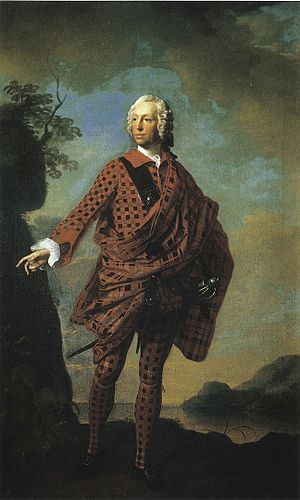Norman MacLeod (The Wicked Man) facts for kids
Quick facts for kids
Norman MacLeod
|
|
|---|---|

Portrait of Norman MacLeod, c. 1747, by Allan Ramsay
|
|
| Member of Parliament for Inverness-shire |
|
| In office 1741–1754 |
|
| Preceded by | Sir James Grant, Bt. |
| Succeeded by | Pryse Campbell |
| The 22nd Chief of Clan MacLeod | |
| Preceded by | John MacLeod (brother) |
| Succeeded by | Norman 'the General' (grandson) |
| Personal details | |
| Born | 29 July 1705 |
| Died | 21 July 1772 (aged 66) St Andrews |
| Resting place | St Andrew's Cathedral |
| Spouses |
Janet Macdonald
(m. 1724; death 1743)Anne Martin
(m. 1748) |
| Children | 8 |
| Parents | Norman MacLeod (father); Anne Fraser (mother) |
Norman MacLeod (1705–1772) was an important Scottish leader in the 1700s. He was the 22nd Chief of Clan MacLeod, a powerful family group in Scotland. He was also a Member of Parliament, which means he helped make laws for the country.
Contents
Life of Norman MacLeod
Early Life and Leadership
Norman MacLeod was born in 1705. He became the Chief of Clan MacLeod when he was very young, only one year old! His older brother, John, was chief for a short time as a baby, but he also passed away. This meant Norman inherited the important role of leading his clan.
As an adult, Norman became a Member of Parliament for the area of Inverness-shire. He served in this role from 1741 to 1754. Even though he was the clan chief, he often lived away from the traditional family home, Dunvegan Castle.
The "Ship of the People" Incident
In 1739, Norman MacLeod was involved in a big event known as the 'Ship of the People' incident. He and another leader, Sir Alexander MacDonald, gathered about 100 people from the Isle of Skye and the Isle of Harris. They planned to send these people to the American Colonies.
At the time, it was legal to transport petty criminals to the colonies. However, these people were not criminals. When some of the victims tried to escape in Ireland, local officials found out. The British government investigated the case. Norman and Sir Alexander said they were not involved, and they were not punished.
Role in the Jacobite Rising
Norman MacLeod and his clan supported the British government during the 1745 Jacobite Rising. This was a conflict where some people wanted to bring back the old royal family, the Stuarts, to the throne. Norman had first seemed to support the Stuarts, but he quickly changed his mind.
He helped the government by gathering about 700 men for their army in 1745. In December, Norman's troops fought against a larger force at the Battle of Inverurie. About 70 of his men were killed, hurt, or captured in this battle.
After the Battle of Culloden
Norman and his clan did not fight in the main Battle of Culloden. Instead, they stayed on the Isle of Skye. After the battle, the Duke of Cumberland ordered his troops to destroy the lands of those who had supported the rebellion.
Norman and the Macdonalds of Sleat joined forces. Together, they had about 1,200 men. They raided the lands of those who had fought against the government. Norman's men also attacked the nearby island of Raasay. The MacLeods of Raasay had supported the other side in the conflict. Norman's men destroyed many houses and boats, and killed many animals on the island.
His Nickname: "The Wicked Man"
Norman MacLeod was known by the nickname "The Wicked Man" (An Droch Dhuine in Scottish Gaelic). This nickname came from a few reasons. One reason was that he spent a lot of money and left his family with a large debt. Because of this debt, some of the clan's old lands were lost.
The "Ship of the People" incident also contributed to his nickname. Later, in the 1900s, another Clan Chief, Dame Flora MacLeod, tried to change his nickname to "The Red Man." She suggested this because of the red color of the tartan he wears in his famous portrait.
Family Life
Norman MacLeod married Janet Macdonald in 1724. They had one son, John, and two daughters, Emilia and Ann. The couple separated for several years but later got back together. Janet passed away in 1743.
Five years later, Norman married Ann Martin in 1748. They had three daughters: Elizabeth, Ann, and Mary. Norman also had two sons outside of his marriages, named Alexander and Norman.
Death and Legacy
Norman MacLeod passed away on July 21, 1772. He was buried in the churchyard of St Andrews Cathedral in St Andrews. His grandson, also named Norman MacLeod, became the next Chief of Clan MacLeod.
Images for kids




